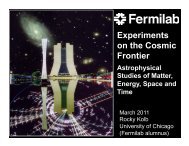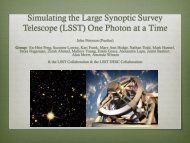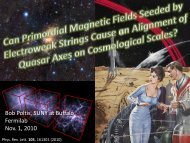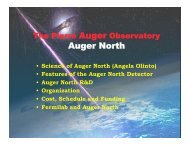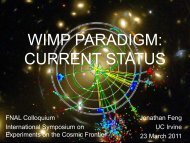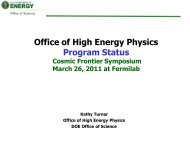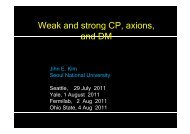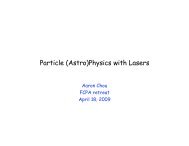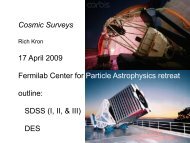5.1×1014 M
5.1×1014 M
5.1×1014 M
Create successful ePaper yourself
Turn your PDF publications into a flip-book with our unique Google optimized e-Paper software.
What causes this?<br />
• Choice of cluster center<br />
• Cluster galaxy<br />
(de)contamina@on<br />
• Shear calibra@on<br />
• NFW concentra@on<br />
• Source redshiF<br />
distribu@on<br />
• N-‐body calibra@on<br />
• …<br />
20 D. E. Applegate et al.<br />
Mean error: 0.77 Mean error: 0.88<br />
My weak lensing mass<br />
Mean error: 0.84 Mean error: 1.38<br />
Your weak lensing mass<br />
Applegate et al. (2012)<br />
Figure 13. Comparison of our mass measurements to results in the literature. Panel a) shows the comparison to Okabe et al. (2010), panel b) to Mahdavi et al.<br />
(2008), panel c) to Bardeau et al. (2007), and panel d) to Pedersen & Dahle (2007). For each comparison, we measure the mass within the overdensity radis r∆<br />
of the respective work. The solid line indicates the one-to-one line, the long-dashed line shows the average of the mass ratios, and the dotted line the median.<br />
For simplicity, the unweighted average is shown, since the measurements are correlated due to overlap in the source galaxy samples.
An observable that scales with mass<br />
What causes this?<br />
It’s not just weak lensing. Systema@c errors in X-‐ray, SZ, and O/<br />
IR mass-‐observables propagate through the system to create<br />
(or hide) discrepancies. Lesson: calibrate mass-‐observables<br />
jointly in fully self-‐consistent way. If you do this, you find the<br />
field is in a significantly worse state than stated systema9c<br />
errors in previous published works would have you believe.<br />
Planck Collaboration: Planck early results. XII.<br />
Planck Early Results XII (2011)<br />
Your mass calibrated to weak lensing My mass calibrated to weak lensing<br />
. 2. Scaled SZ signal measurements, ˜Y500, binnedbyrichness,N200. Theleft-handpanelpresentstheresultsfortheJohnston et al. (20<br />
00 − N200 relation, the right-hand panel for the Rozo et al. (2009) relation.Ineachcase,thereddiamondsshowthebin-average,redshift-sca<br />
0 calculated as the weighted mean of all individual measurements (e.g., Fig. 1) inthebin,wheretheweightsaretakenfromtheestimatedfi<br />
se. The thick error bars show the corresponding uncertainty on the bin-average SZ signal, while the lighter error bars indicate the uncertai<br />
nd by bootstrap analysis; they are larger due to the presence of intrinsic scatter within the bins, most notable at high richness (see Fig. 4). T<br />
e points represent the model prediction for each bin found by averaging, with the same weights as the data, the SZ signal expected from
Cluster-‐abundance cosmology<br />
234 G. Mark Voit: Tracing cosmic evolution with clusters of galaxies<br />
• Cosmological parameters:<br />
However, this problem is not as severe as one might<br />
expect because the evolution in the mass function itself<br />
is so dramatic, – Dark especially energyfor equa@on M1. This of state: part of w the =<br />
review discusses P/
ARI 2 August 2011 10:40<br />
Sample size<br />
10 6<br />
10 5<br />
10 4<br />
10 3<br />
10 2<br />
10 1<br />
10 0<br />
Cluster surveys<br />
ACO<br />
B50<br />
EMSS<br />
1990<br />
RCS1<br />
MaxBGC<br />
BCS<br />
REFLEX<br />
400d<br />
MACS<br />
RDCS<br />
ACT<br />
2000<br />
Year<br />
SPT<br />
2010<br />
10 14 M ☉<br />
10 15 M ☉<br />
SPT 2500 deg 2<br />
SPT 720 deg 2<br />
(Reichardt et al., 2012)<br />
Figure 1<br />
Yields from modern surveys of clusters used for cosmological studies are shown, with symbol size<br />
proportional to median redshift. Samples selected at optical ( gray filled circles), X-ray (red squares), and<br />
millimeter (blue triangles) wavelengths are discussed in Section 3.2. Stars and horizontal lines (purple) show<br />
full sky counts of halos expected in the reference CDM cosmology (see Section 2) with masses above 1015 Adapted from Allen, Evrard, & Mantz (2012)<br />
14<br />
MCXC<br />
•
7<br />
The thermal<br />
Sunyaev-Zel’dovich<br />
effect"<br />
7
photon by roughly kBTe/mec 2 , causing a small (⇥1 mK) distortion in the CMB<br />
spectrum. Figure 1 shows the SZE spectral distortion for a fictional cluster that is<br />
over 1000 times more massive than a typical cluster to illustrate the small effect.<br />
The SZE appears as a decrease in the intensity of the CMB at frequencies below<br />
⇥218 GHz and as an increase at higher frequencies.<br />
The derivation of the SZE can be found in the original papers of Sunyaev &<br />
Zel’dovich (Sunyaev & Zel’dovich 1970, 1972), in several reviews (Sunyaev &<br />
The Sunyaev-‐Zel’dovich effect<br />
Zel’dovich 1980a, Rephaeli 1995, Birkinshaw 1999), and in a number of more re-<br />
cent contributions that include relativistic corrections (see below for references).<br />
This review discusses the basic features of the SZE that make it a useful cosmological<br />
tool.<br />
Take-‐home message #1<br />
SZ signal is not an emissive process but a<br />
spectral disor@on, so with beam well<br />
matched to the size of clusters, it’s nearly<br />
redshiF independent.<br />
Figure 1 The cosmic microwave background (CMB) spectrum, undistorted (dashed<br />
line) and distorted by the Sunyaev-Zel’dovich effect (SZE) (solid line). Following<br />
Sunyaev & Zel’dovich (1980a) to illustrate the effect, the SZE distortion shown is for<br />
a fictional cluster 1000 times more massive than a typical massive galaxy cluster. The<br />
SZE causes a decrease in the CMB intensity at frequencies ⇥218 GHz and an increase<br />
at higher frequencies.<br />
Measured SZ spectrum <br />
of A2163<br />
Take-‐home message #2<br />
SZ signal is a direct probe of total thermal<br />
energy, and so is a good proxy for cluster<br />
mass.
South Pole Telescope<br />
M500 (10 14 -1<br />
Msun h70) detected clusters<br />
10<br />
SPT-720 deg 2<br />
Planck-ESZ<br />
ROSAT-All sky<br />
Reichardt et al. (2012)<br />
1<br />
0.0 0.5 1.0 1.5<br />
z
Calibra@ng mass-‐observables with<br />
weak lensing<br />
NDRA CLUSTER COSMOLOGY PROJECT. II. 1047<br />
that the scatter in<br />
in Mtot for a given<br />
X-ray analysis, as<br />
al mass in simulated<br />
robust X-ray mass<br />
YX,isdefinedas<br />
(10)<br />
ng the cluster X-ray<br />
ii 0.15 r500 − 1 r500,<br />
phere r500, derived<br />
otal thermal energy<br />
atedlow-frequency<br />
ich 1972). The total<br />
nstobeaverygood<br />
al. 2004;Motletal.<br />
n the simplest selfes<br />
with the cluster<br />
• Hydrosta@c equilibrium<br />
◌ Weak lensing<br />
Vikhlinin et al. (2009)<br />
Figure 11. Calibration of the Mtot–YX relation. Points with errorbars show<br />
Chandra results from Vikhlinin et al. (2006) withsevenadditionalclusters<br />
(Section 4). The dashed line shows a power law fit (excluding the lowest mass<br />
cluster) with the free slope. The dotted line shows the fit with the slope fixed<br />
at the self-similar value, 3/5 (parametersforbothcasesaregiveninTable3).<br />
Open points show weak lensing measurements from Hoekstra (2007;thesedata
Weak lensing
Weak lensing<br />
Williamson, Oluseyi, & Roe (2007)
SPT targeted weak lensing sample<br />
o 33 clusters at 0.3 < z < 1.3<br />
o Complete SZ, X-‐ray coverage<br />
o Spectroscopy, Spitzer NIR, and<br />
mul@band OIR from the ground<br />
Ground WL sample<br />
• Magellan/Megacam camera<br />
• 19 clusters at 0.3 < z < 0.6<br />
• Imaging in (u)gri in 2011A+B<br />
Space WL sample<br />
• HST/ACS camera<br />
• 14 clusters at 0.6 < z < 1.3<br />
• Imaging in F606W and F814W<br />
in Cycle 18 and Cycle 19<br />
• Added deep imaging with VLT<br />
• Observa@ons ongoing
SPT-‐CL J0348-‐4514, z = 0.39, M 500 = 5.2×10 14 M sun
SPT-‐CL J0546-‐5345, z = 1.07, M 500 = 8.0×10 14 M sun
Stellar locus photometric calibra@on<br />
Magellan/IMACS stellar locus<br />
SLR: Stellar Locus Regression<br />
Allows for calibra@on of<br />
colors and magnitudes<br />
without the tradi@onal use<br />
of standard star fields<br />
Successfully used by<br />
Weighing the Giants to<br />
obtain photo-‐z’s<br />
Adapted from<br />
High et al. (2009)<br />
SLR gives dereddened colors to 0.01−0.03 mag (SDSS)<br />
and magnitudes to 0.05 mag (2MASS).
− i<br />
Stellar locus photometric calibra@on<br />
Magellan/Megacam stellar locus<br />
i − J<br />
g − r r − i<br />
SLR gives dereddened colors to 0.01−0.03 mag (SDSS)<br />
and magnitudes to 0.05 mag (2MASS).
s, in<br />
ation<br />
and<br />
nly a<br />
The<br />
ples,<br />
cribe<br />
and<br />
laxy<br />
stars<br />
f the<br />
hese<br />
from<br />
een<br />
few<br />
is more difficult for smaller or fainter galaxies, and the intrinsic morphology<br />
distribution of galaxies varies as a function of magnitude<br />
in images other than set B, ngals and σ γ are likely to be correlated<br />
in a complicated fashion. Es@ma@ng Galaxy selectionshear effects and weighting<br />
schemes are discussed in Sections 5.6 and 5.7.<br />
4.3 Shear calibration bias and residual shear offset<br />
Shear pipelines that we use:<br />
• ground data: Henk Hoekstra (HH)<br />
• space data: Tim Schrabback (TS)<br />
As with STEP1, we assess the success of each method by comparing<br />
the mean shear measured in each image with the known input shears<br />
γ input<br />
i . We quantify deviations from perfect shear recovery via a<br />
linear fit that incorporates a multiplicative ‘calibration bias’ m and an<br />
additive ‘residual shear offset’ c. With a perfect shear-measurement<br />
method, both of these quantities would be zero. Since the input shear<br />
is now applied in random directions, we measure two components<br />
each of m and c, which correspond to the two components of shear:<br />
Full pipelines blind-‐tested by the Shear<br />
TesHng Program (STEP: Heymans et al.<br />
2006; Massey et al. 2007). Includes<br />
realis@c point-‐spread func@ons.<br />
STEP bias sta@s@cs:<br />
〈 ˜γ1〉−γ input<br />
1<br />
〈 ˜γ2〉−γ input<br />
2<br />
= m1γ input<br />
1<br />
= m2γ input<br />
2<br />
+ c1<br />
+ c2.<br />
(43)<br />
Shear code recovers truth with no measurable<br />
C○ 2007 The Authors. Journal compilation C○ 2007 RAS, MNRAS 376, 13–38<br />
Massey et al. (2007)<br />
Figure 6. Comparison of shear-measurement accuracy from different meth-<br />
addi9ve bias (c) and with mul9plica9ve bias<br />
ods, in terms of their mean residual shear offset 〈c〉 and mean shearcalibration<br />
bias (m) 〈m〉. of 2% In the ortop beRer. panel, these parameters have been averaged<br />
over both components of shear and all six sets of images; the bottom panel<br />
includes only image sets A, B, C and F, to avoid the two highly elliptical<br />
PSFs. Note that the entire region of these plots lie inside the grey band that<br />
indicated good performance for methods in Fig. 3 of STEP1. The results<br />
from methods C1, SP, MS1 and ES1 are not shown here.<br />
age set<br />
bias is<br />
elliptic<br />
Strang<br />
pixelliz<br />
betwee<br />
not hav<br />
indeed<br />
succes<br />
Pixe<br />
about t<br />
it may<br />
conseq<br />
able to<br />
objects<br />
high o<br />
galaxie<br />
if Nyqu<br />
etry, bu<br />
pixelliz<br />
seeing,<br />
seeing)<br />
unders<br />
worse<br />
there.<br />
We<br />
lization<br />
ential c<br />
study o<br />
(in pre<br />
bration<br />
pixels,<br />
Becaus<br />
of shea<br />
tics. H<br />
ual clu<br />
The ne<br />
pixel s<br />
mean<br />
promis<br />
method
Magellan/Megacam PSF performance<br />
PSF polariza9on residuals are 0.003 to 0.005 rms,<br />
no appreciable residual in radial bins.<br />
High et al. (2012)
Magellan/Megacam catalogs<br />
Source redshiF distribu@on and<br />
cluster-‐galaxy decontamina@on<br />
Procedure for ground sample:<br />
o Cut out i > 25 24<br />
o Cut out |z phot − z cluster| < 0.05 region in color-‐color<br />
space<br />
o Es@mate mean and variance of β from reference<br />
photo-‐z catalogs using the same cuts<br />
CFHTLS Deep field photo-‐z catalogs<br />
Coupon et al. 2009<br />
Low contamina9on<br />
near z cluster<br />
High et al. (2012)
Magellan/Megacam catalogs<br />
Source redshiF distribu@on and<br />
cluster-‐galaxy decontamina@on<br />
Procedure for ground sample:<br />
o Cut out i > 25 24<br />
o Cut out |z phot − z cluster| < 0.05 region in color-‐color<br />
space<br />
o Es@mate mean and variance of β from reference<br />
photo-‐z catalogs using the same cuts<br />
Magellan/Megacam catalogs<br />
High et al. (2012)
O/NIR: Magellan/Megacam<br />
SZ: SPT S/N<br />
κ: Kaiser Squires reconstruc@on<br />
Color scale: SZ S/N Black contours: κ<br />
The results<br />
SPT-‐CL J2145-‐5644, z = 0.48, M 500 = 6.5×10 14 M sun<br />
White contours: SZ S/N Cyan contours: κ
The results<br />
SPT-‐CL J2145-‐5644, z = 0.48, M 500 = 6.5×10 14 M sun
O/NIR: Magellan/Megacam<br />
SZ: SPT S/N<br />
κ: Kaiser Squires reconstruc@on<br />
Color scale: SZ S/N Black contours: κ<br />
The results<br />
SPT-‐CL J0348-‐4514, z = 0.39, M 500 = 5.2×10 14 M sun<br />
White contours: SZ S/N Cyan contours: κ
The results<br />
SPT-‐CL J0348-‐4514, z = 0.39, M 500 = 5.2×10 14 M sun
O/NIR: VLT/FORS2 & Spitzer<br />
SZ: SPT S/N<br />
κ: Kaiser Squires reconstruc@on<br />
Color scale: SZ S/N Black contours: κ<br />
The results<br />
SPT-‐CL J0546-‐5345, z = 1.07, M 500 = 8.0×10 14 M sun<br />
Cyan contours: κ
The results<br />
SPT-‐CL J0546-‐5345, z = 1.07, M 500 = 8.0×10 14 M sun
O/NIR: VLT/FORS2<br />
SZ: SPT S/N<br />
κ: Kaiser Squires reconstruc@on<br />
Color scale: SZ S/N Black contours: κ<br />
The results<br />
SPT-‐CL J2331-‐5051, z = 0.58, M 500 = 5.1×10 14 M sun<br />
Cyan contours: κ
O/NIR: HST/ACS<br />
SZ: SPT S/N<br />
κ: Kaiser Squires reconstruc@on<br />
Color scale: SZ S/N Black contours: κ<br />
The results<br />
SPT-‐CL J2331-‐5051, z = 0.58, M 500 = 5.1×10 14 M sun<br />
Cyan contours: κ
The results<br />
SPT-‐CL J2331-‐5051, z = 0.58, M 500 = 5.1×10 14 M sun
O/NIR: HST/ACS & Spitzer<br />
SZ: SPT S/N<br />
κ: Kaiser Squires reconstruc@on<br />
Color scale: SZ S/N Black contours: κ<br />
The results<br />
SPT-‐CL J2106-‐5844, z = 1.13, M 500 = 8.4×10 14 M sun<br />
Cyan contours: κ
The results<br />
SPT-‐CL J2106-‐5844, z = 1.13, M 500 = 8.4×10 14 M sun
Calibra@on to N-‐body simula@ons<br />
ArHcle NFW WL mass bias<br />
Becker & Kravtsov<br />
2012<br />
-‐5% to -‐10%<br />
Rasia et al. 2012 -‐5% to -‐10%<br />
Bahe et al. 2012 -‐5%<br />
High et al. 2012 -‐5% to -‐10%<br />
Our tests:<br />
• Use two flavors of Dark Energy Survey mocks at 220<br />
deg 2 and 5k deg 2 ; fake galaxies with realis@c color,<br />
magnitude, and clustering proper@es (ADDGALS, R.<br />
Wechsler et al.)<br />
• Replicate our color and magnitude selec@on for all<br />
massive 0.25 < z < 0.65 halos<br />
• Also geared up on simula@ons from Becker &<br />
Kravtsov (2012)<br />
WL NFW masses recover truth with overall bias of -‐5% to -‐10%.
WL test of joint SZ/X-‐ray masses<br />
Mean calibraHon from ground<br />
sample: 1.26 ± 0.16<br />
Mean calibraHon from space<br />
sample: 1.16 ± 0.26<br />
High et al. (in prep.)
=0.655 ± 0.02 (1.16)<br />
AWL = 4G<br />
R2 BWL ↵Mpiv 1c2 Dpiv =0.0457 ⇥ (BWL0.13) (±BWL0.06) (1.17)<br />
WL calibraHon of M – YSZ :<br />
A first look at the SPT data<br />
BWL = (1.18)<br />
CWL =1± 0.01 (1.19)<br />
YSZ measured with Rapid Gridded<br />
Likelihood Es@mator (T. Montroy et al.<br />
in prep.).<br />
DWL =0± 0 (fixed) (1.20)<br />
EWL =0± 0 (fixed) (1.21)<br />
Assume self-‐similar scaling with free<br />
normaliza@on parameter,<br />
Astrophysical scaling relations<br />
M500<br />
10 14 M<br />
= eA<br />
✓<br />
YsphD2 2/3<br />
AE(z) 10 5 Mpc 2<br />
◆3/5<br />
19 SPT-‐detected clusters used here:<br />
• 7 from space sample<br />
• 12 from ground sample<br />
Aghanim et al. (2012) and Applegate et<br />
al. (2012) have also given evidence for<br />
-‐30% WL biases in LoCuSS results<br />
(Okabe et al. 2010; Marrone et al.<br />
2012).<br />
(1.22)<br />
These results are preliminary.<br />
High et al. (in prep.)
A SZ<br />
jak 20<br />
at ⇠ > 2. This maximization bias comes from having<br />
maximized ⇠ across possible cluster positions and filters 2<br />
explain<br />
scales, e↵ectively adding three degrees of freedom to the<br />
levels<br />
fit with ⇠ analogous to a 0.5 0.6 0.7 0.8 0.9 1.0 1.1 verse,<br />
at z =<br />
8<br />
Implica@on for cosmology<br />
creasin<br />
of CM<br />
Fig. 5.— Assuming a wCDM cosmology, the two-dimensional<br />
marginalized constraints on ASZ and 8. Contours show the a 95%<br />
68% and 95% confidence regions for the SPTCL +H0+BBN (red) In F<br />
and CMB+BAO+SNe+SPTCL (green) data sets. The horizontal and 8<br />
black dashed line is the center of the theory prior on ASZ.<br />
after13i the ma<br />
that find some evidence for a sterile neutrino species. sumeIt<br />
has been pointed out that these measurements areing most the<br />
wCDM<br />
consistent with two sterile neutrinos and ⌃m⌫& 1.7 ⌃m⌫< eV<br />
SPTCL+H0+BBN (Kopp et al. 2011).<br />
CDM+(m<br />
0.6<br />
Therefore, we >0)<br />
consider the joint Ne↵= cos-<br />
8<br />
CMB+BAO+SNe mological constraints<br />
CMB+H<br />
on Ne↵ 0+BAO<br />
and ⌃m⌫ to compare additio with<br />
+SPT these terrestrial results. CMB+H0+BAO+SPTCL 8 by a<br />
CL 0.5<br />
With only threeCMB+H neutrino 0+SPT species, CL we would expect by a fa<br />
Ne↵= 3.046, a value slightly larger than three because data d<br />
6<br />
0.4<br />
of energy injection from electron-positron annihilation<br />
ized on<br />
at the end of neutrino freeze-out (Dicus et al.<br />
maxim<br />
1982;<br />
Lopez<br />
0.3<br />
⌃m⌫=<br />
et al. 1999; Mangano et al. 2005). As Ne↵ in-<br />
As n<br />
creases, the contribution to the gravitational potential<br />
4<br />
of 0.2<br />
power<br />
the additional neutrino perturbations boosts thevored early<br />
growth of dark matter perturbations (Bashinsky & Seljak<br />
0.1<br />
the ne<br />
2004), which also increases 8 (Hou et al. 2011). its phy As<br />
2<br />
explained in Section 5.2, adding neutrino mass at the<br />
0.0<br />
Ne↵ m<br />
levels considered here only a↵ects the low-redshift theuni mo<br />
0.5 0.6 0.7 0.8 0.9 1.0 1.1 verse, 0.65 suppressing 0.70 structure 0.75 0.80 formation, 0.85 and lowering Keisler 8<br />
at z = 0. Therefore, increasing 8 Ne↵ will also allowthe an in- ex<br />
8<br />
creasing ⌃m⌫. Keisler et al. (2011) used a combination the mo<br />
Fig. 6.— of Assuming CMB+H0+BAO a ⇤CDM cosmology data to withconstrain massive neutrinos, ⌃m⌫< 0.69also eV at w<br />
the two-dimensional a 95% CL, marginalized<br />
8 =0.803 constraints ± 0.056, and on Ne↵= ⌃m⌫ and 3.98 ± 0.43. genera<br />
8. Contours show the 68% and 95% confidence regions for<br />
the CMB+H0+BAO In Figure (gray, 7, dashed), we showCMB+H0+BAO+SPT the constraints on Ne↵, cosmo ⌃m⌫,<br />
CL<br />
(orange, solid), and and 8, usingtheCMB+H0+BAO CMB+H0+SPTCL (blue, dot-dashed) data data set, before8, and wh<br />
sets. The SPT after CLincluding data improves the theSPTCL constraints data. on 8InandTable, ⌃m⌫, 5 we improv give<br />
by factors of 1.8 and 1.4, respectively.<br />
the marginalized constraints. When varying Ne↵ ⌃m⌫ we asc<br />
sume consistency with BBN for our constraints. conser Us-<br />
Recent ing measurements the CMB+H have+BAO+SPT shown a ⇠2 preference data set, for we constrain ical m<br />
2 . Additionally, h⇠i relates to<br />
⇠ by a Gaussian scatter of unit width. Simulations have<br />
been used to verify that these approximations introduce<br />
negligible bias or scatter compared to the Poisson noise<br />
of the sample. For further details we refer the reader to<br />
V10.<br />
We assume a ⇣ M500 relation of the form<br />
✓<br />
M500<br />
⇣ = ASZ<br />
3 ⇥ 1014M h 1<br />
◆BSZ ✓ cally spaced redshifts between 0
Summary<br />
o Weak lensing quality data obtained for 33 clusters<br />
o 19 clusters at 0.3 < z < 0.6 with Magellan/Megacam<br />
o 14 clusters at 0.6 < z < 1.3 with HST/ACS<br />
o full SZ, X-‐ray, and spectroscopic overlap<br />
o First look at 28 clusters<br />
o provides 14% direct mass calibra@on<br />
o shows weak evidence for low mass es@mates<br />
o Analysis now undergoing refinement and scru@ny<br />
o First<br />
o WL detec@ons using Megacam at Magellan<br />
o direct calibra@on of code used on real data to N-‐body<br />
simula@ons<br />
o Matching the staHsHcal power of the SPT CL data set will<br />
require a sub-‐3% calibraHon of mass. SPT CL poised to<br />
achieve δw = 0.035<br />
o Ancillary science<br />
SPT<br />
Magellan<br />
HST
EXTRA SLIDES
asic imaging information for the five<br />
of which has already been transformed to the SDSS<br />
hose be slopes a population are equal to thethat color-term coefficients,<br />
this is not an exhaustive test.<br />
The mean tangential shear as a fun<br />
the plane of the sky at the cluster re<br />
projected surface density, Σ(R), as (M<br />
where c is the speed of light, G is the gravitational constant, and<br />
er the source redshift β ≡ Dls/Ds is the lensing efficiency. Quantities D are angular-<br />
ure ometric is availableerror, in the online δi, journal.) by diameter distances, and l indicates the lens (the cluster) while s<br />
iCFHT > 24 − δi and indicates<br />
Weak<br />
sources.<br />
lensing<br />
photometric accuracy The observable quantity is not the shear but the reduced shear,<br />
basic WL-SZ imaging massinformation ratios at for the g, whichrelatestotheshearas<br />
five<br />
ly stimated subdominant from the to median the magnitude of<br />
-to-noise ematic uncertainties.<br />
ratio is five. Seeing is estimated<br />
Observable quan@ty: reduced shear, g. γ = (1 − κ)g (8)<br />
of photometric zero-point errors on the<br />
ios. Systematic errors in photometry 5 enter<br />
is through theShear estimation relates oftothe mass critical via:<br />
ch cluster (Section 4.2). We estimate this<br />
ly available photometric redshift catalogs<br />
which we apply the same photometric<br />
o the Megacam catalogs. If there is an<br />
i ′ this is the shear component oriented at 45<br />
-band zero point relative to that of the<br />
n we effectively probe a population that<br />
from which we infer the source redshift<br />
the effect of photometric error, δi, by<br />
hoto-z catalogs at iCFHT > 24 − δi and<br />
lysis. The level of photometric accuracy<br />
auses changes in the WL-SZ mass ratios at<br />
which is significantly subdominant to the<br />
and the largest systematic uncertainties.<br />
◦ with respect to γ+.<br />
The azimuthally averaged cross shear 〈γ×〉 as a function of<br />
radius provides a diagnostic for residual systematics, because no<br />
astrophysical effects, including lensing, produce such a signal.<br />
As a consequence, a non-zero 〈γ×〉 indicates the presence of<br />
some types of residual systematic error, though we note that<br />
this is not an exhaustive test.<br />
The mean tangential shear as a function of radial distance in<br />
the plane of the sky at the cluster redshift, R, dependsonthe<br />
projected surface density, Σ(R), as (Miralda-Escude 1995)<br />
〈Σ〉(< R) − Σ(R)<br />
〈γ+〉(R) = . (6)<br />
Σcrit<br />
This depends on the critical surface density,<br />
Σcrit = c2<br />
s the shear component oriented at 45<br />
The signal is a func@on of lens and source redshiFs through: 1<br />
, (7)<br />
4πG Dlβ<br />
where c is the speed of light, G is the gravitational constant, and<br />
β ≡ Dls/Ds is the lensing efficiency. Quantities D are angulardiameter<br />
distances, and l indicates the lens (the cluster) while s<br />
indicates sources.<br />
The observable quantity is not the shear but the reduced shear,<br />
g, whichrelatestotheshearas<br />
γ = (1 − κ)g (8)<br />
5<br />
◦ with respect to γ+.<br />
azimuthally averaged cross shear 〈γ×〉 as a function of<br />
s provides a diagnostic for residual systematics, because no<br />
physical effects, including lensing, produce such a signal.<br />
consequence, a non-zero 〈γ×〉 indicates the presence of<br />
types of residual systematic error, though we note that<br />
s not an exhaustive test.<br />
e mean tangential shear as a function of radial distance in<br />
lane of the sky at the cluster redshift, R, dependsonthe<br />
cted surface density, Σ(R), as (Miralda-Escude 1995)<br />
〈Σ〉(< R) − Σ(R)<br />
〈γ+〉(R) = . (6)<br />
Σcrit<br />
depends on the critical surface density,<br />
Σcrit = c2<br />
estimated from the median magnitude of<br />
l-to-noise ratio is five. Seeing is estimated<br />
t of photometric zero-point errors on the<br />
tios. Systematic errors in photometry enter<br />
sis through the estimation of the critical<br />
ach cluster (Section 4.2). We estimate this<br />
cly available photometric redshift catalogs<br />
o which we apply the same photometric<br />
to the Megacam catalogs. If there is an<br />
m i<br />
1<br />
, (7)<br />
4πG Dlβ<br />
e c is the speed of light, G is the gravitational constant, and<br />
A model for the project mass density,
Advantages<br />
1. Extremely simple theore@cal<br />
rela@onship between total<br />
mass and observables<br />
– A key piece of evidence for<br />
the existence of dark maver<br />
– Independent of maver’s<br />
dynamical state or history<br />
2. Rela@vely straighworward to<br />
realis@cally simulate in the<br />
same N-‐body simula@ons that<br />
cosmological fixng func@ons<br />
are tuned to<br />
– Ray tracing<br />
– Source selec@on<br />
Weak lensing<br />
Challenges<br />
1. Accurately es@ma@ng<br />
reduced shear<br />
– Correct for the smearing and<br />
shearing by anisotropic point-‐<br />
spread func@ons<br />
– Cluster galaxies contaminate<br />
shear profiles<br />
2. Accurately es@ma@ng source<br />
redshiF distribu@on<br />
– Photo-‐z’s are hard!<br />
– Availability of photo-‐z’s at very<br />
faint magnitudes or very high<br />
redshiF is scant
South Pole Telescope<br />
• (Sub)millimeter wavelength<br />
telescope:<br />
– 10 meter aperture<br />
– 1’ FWHM beam at 150 GHz<br />
– Off-‐axis Gregorian op@cs design<br />
– 20 micron RMS surface accuracy<br />
– 1 arc-‐second poin@ng<br />
– Fast scanning, up to 4 deg/sec in<br />
azimuth<br />
• SZ receiver:<br />
– 1 sq. deg FOV<br />
– ~960 background limited pixels<br />
– Observe in 3+ bands between 95-‐220<br />
GHz simultaneously<br />
– Modular focal plane<br />
• Polarimeters are currently deployed<br />
for CMB polariza@on and deep-‐SZ<br />
studies (SPTpol)



